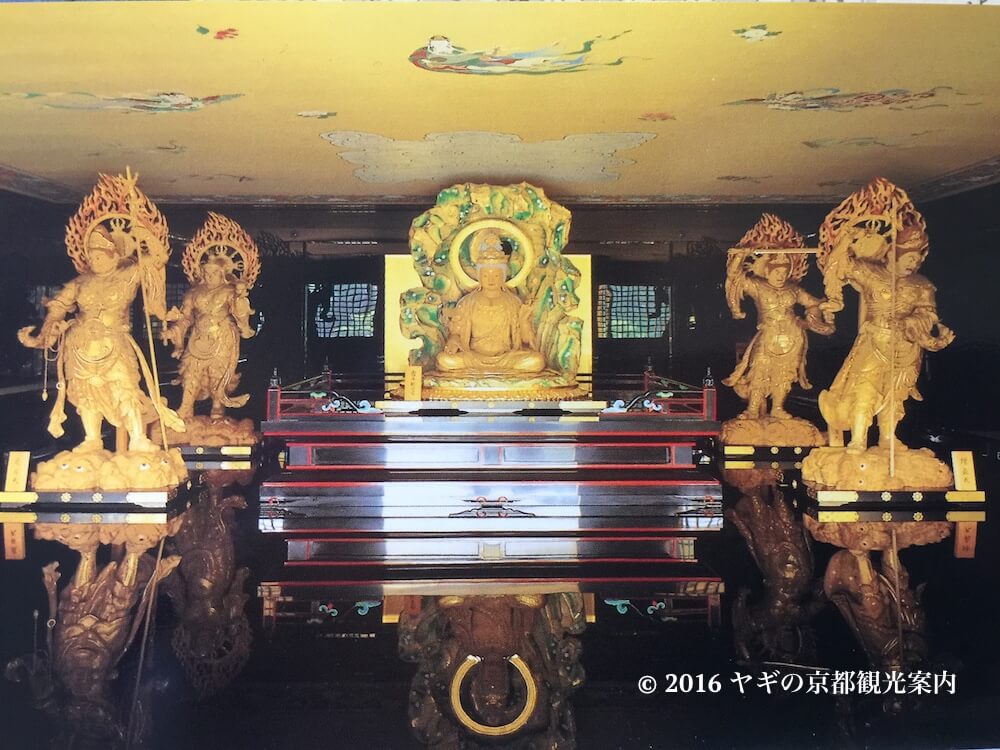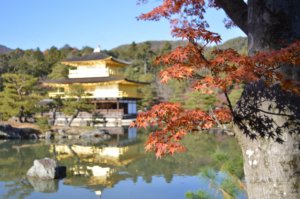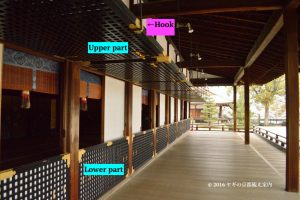THE GIST OF THIS ARTICLE
- Page 1 Introduction, About Kinkakuji, the golden pavilion (Shariden), the 1st floor.
- Page 2 The 2nd floor, the 3rd floor, the way to admire Sahriden
- Page 3 The prolific garden, night illumination on post card
- Page 4 Other Must-sees
- Page 5 Autume leaves and snow, access, etc.
The following is the contents of this article.
Introduction
In this post, I’ll show you what the Golden Pavilion (Shariden) is with a inside view, the meaning of the garden and other must-sees. 合掌
What is Kinkakuji (金閣寺)?
A Buddhist temple known as Kinkakuji (金閣寺)is “Hokuzan Rokuonji (北山鹿苑寺)” with many facilities and one of them is “Shariden (舎利殿)” also known as “the Golden pavilion.”
Shariden was covered with sheets of gold actually. This is the reason we call it Kinkakuji. Kinkakuji means “a temple with golden pavilion.
Kinkakuji used to be a residence belonged to Ashikaga Yoshimitsu, the third Shogun of Ashikaga Shogunate. After his death, the temple was named “Rokuonji” after his Buddhist name and became a temple of Rinzai school. Kinkakuji, its garden, and belongings represent so called “Kitayama period/culture.”
Rokuonji was designated as a World Heritage site in 1994.
A Short History of Kinkakuji
The place now Kinkakuji is located was called “Saionji temple” which belonged to the Saionji family, one of the most prosperous court noble clans in the Heian period(794-1185).
In the 13th century, Saionji Kinmune planned to invite the Emperor Godaigo to Saionji temple and to assassinate him in order to overthrow the status quo. Finally his plan failed and he was executed and his property, including Saionji temple, was confiscated.
After the incident, Ashikaga Yoshimitsu bought Sainoji temple when his political career was at the zenith in the 14th century. He constructed “Kitayama-den” as his residence. This is the origin of Kinkakuji (Shariden). At that time, there was a pavilion called Tenkyo-kaku. It is believed there was a roofed wooden bridge connected these two pavilions.
He exercised his political power though he had gave up his “Shogun throne” to his son many years ago. Shariden also worked as “Kasiyo,” a place where people gather. Yoshimitsu invited people there for cultural enjoyments.
In the 15th century, “Ohnin-no ran,” the largest civil war in the middle ages in Japan was broke up. The war burned down the whole Kyoto city but Kinkakuji escaped narrowly these fires.
In the 19th century, the Meiji government ordered the separation of Shinto and Buddhism (In Japan, Shinto and Buddhism had been fused for centuries.) and Kinkakuji, as same as other temples, lost the privileges they had.

Shinbutsu Shugo? Check this out.

Due to these incidents, Kinkakuji fell into decline. In 1950, a trainee monk set a fire on Shariden. The fire burned Shariden, including the Buddhist statues, down to ashes.
After the fire, Shariden was reconstructed in 1952.
The construction of Syariden 舎利殿
We are not allowed to enter Shariden. The pictures of the inside of the pavilion are the photos of postcards I bought at a souvenir shop in Kinkakuji temple.
Shariden is a facility enshrined the ashes of Siddhartha Gautama. As I tell you later, it is on the third floor. The garden of Saihoji temple affected the land scape of Kinkakuji: It is the first garden has a pavilion at a pondside.

Saihoji temple paved the way for a pavilion located at a pondside.
When it was reconstructed after the fire, the surface of the 2nd and 3rd floor was covered with sheets of gold. About 45lbs. of solid gold made 200 thousand of sheets.
Unfortunately, in a decade, these sheets came off due to the sunbeam. A sheet of gold has a large number of small, invisible holes. Through them, the ultraviolet light destroyed the plaster under the sheets.

But the pavilion didn’t look miserable. It rather looked “Shibui.”
In 1986, “the renovation of (the Imperial period) Showa” started. This time, the sheets are five times the thickness of those in 1950. About 400 lbs. of gold made 200 thousand of sheets. It cost 100 million JPY.
Hossui-in, the 1st floor 第一層 法水院
The 1st floor is called “Hosui-in”. The wall (It is a kind of door actually) of the floor reveals that it was built in the “Shinden-zukuri (寝殿造)’ fashion, the style of residence for the court nobles. The wall is called “Haji-tomi (半蔀)” (The picture above is the Haji-tomi of Daikakuji temple.).
In summer time we can take the lower part out of the pillars (It is installed into the ditches of the pillars), in spring and fall we can open only the upper part. On the other hand, in winter time, we put the lower part into pillars and close the upper part.
Haji-tomis are so thick and heavy that it needs servants to remove, install, and open them. They are suitable for the four seasons in Japan. This shows a good example about our idea on house. We, Japanese, do not tell the “outside” from the inside of house exactly.
You can see them in front of Shariden over the pond.
From left to right:
- A statue of Ashikaga Yoshimitsu, the founder of Kinkakuji.
- A statue of crowned Siddhartha Gautama (宝冠釈迦如来像).
- A hand scroll. It reads, “開山夢窓国師 (A name of monk who established Kinkakuji),” “開祖達摩円覚大師 (The founder of Zen),” and “歴代祖師諸位禅師 (All Zen monks).”

A statue of Siddhartha Gautama doesn’t have a crown usually becaue he is an enlightened person who has no need to be ornamented. This statue wears crown. It tells us he is still on the way to the enlightenment. I suppose it tells us the importance of the Buddhist training.

There are two types of founder. One is a person (s) who makes financial contribution. The other is a monk(s) who establishes a facility as a temple.
ヤギの京都観光案内/KYOTO GOAT BLOGをもっと見る
購読すると最新の投稿がメールで送信されます。







